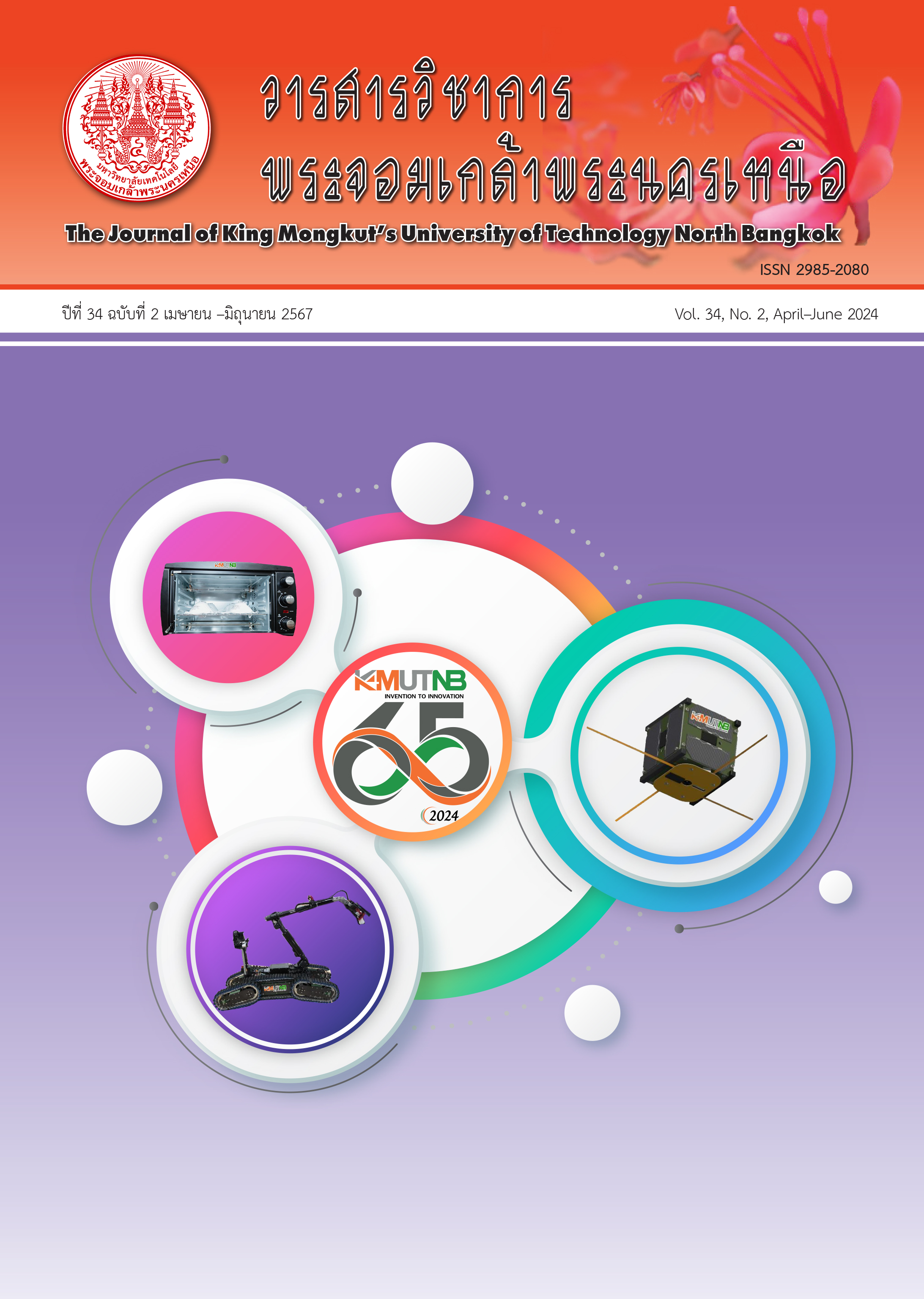ตัวแบบผสมสำหรับพยากรณ์ข้อมูลอนุกรมเวลาปริมาณหน่วยจำหน่ายไฟฟ้าบ้านอยู่อาศัยรายเดือนของประเทศไทย
Main Article Content
บทคัดย่อ
การวิจัยครั้งนี้มีวัตถุประสงค์เพื่อพัฒนาตัวแบบที่เหมาะสมในการพยากรณ์ข้อมูลอนุกรมเวลาปริมาณหน่วยจำหน่ายไฟฟ้าบ้านอยู่อาศัยรายเดือนของประเทศไทย เก็บรวบรวมข้อมูลจากการไฟฟ้าส่วนภูมิภาค ตั้งแต่เดือนมกราคม 2553 ถึงเดือนกุมภาพันธ์ 2565 จำนวน 146 ค่า จำนวน 4 ชุด ได้แก่ ภาคเหนือ ภาคตะวันออกเฉียงเหนือ ภาคกลาง และภาคใต้ การสร้างตัวแบบการพยากรณ์มีทั้งหมด 5 ตัวแบบ ได้แก่ ตัวแบบ SARIMA ตัวแบบ ANN ตัวแบบ SARIMA – ANN ตัวแบบ SARIMA – ANN – REG และตัวแบบ Propose ซึ่งเป็นตัวแบบที่ผู้วิจัยนำเสนอ การสร้างตัวแบบได้ประยุกต์ใช้วิธีการวิเคราะห์องค์ประกอบของข้อมูลอนุกรมเวลาเชิงประจักษ์ (Empirical Mode Decomposition; EMD) เพื่อลดสัญญาณแกว่งไวของข้อมูลก่อนนำไปสร้างตัวแบบผสม SARIMA – ANN – REG การดำเนินการวิจัยทำการแบ่งข้อมูลออกเป็น 2 ชุด คือ ชุดที่ 1 ข้อมูลฝึกฝน (Training Data Set) ตั้งแต่ เดือนมกราคม 2553 ถึงเดือนธันวาคม 2562 จำนวน 120 ค่า สำหรับสร้างตัวแบบการพยากรณ์ และชุดที่ 2 ข้อมูลทดสอบ (Testing Data Set) ตั้งแต่ เดือนมกราคม 2563 ถึงเดือนกุมภาพันธ์ 2565 จำนวน 26 ค่า สำหรับเปรียบเทียบความแม่นยำของตัวแบบการพยากรณ์ ด้วยเกณฑ์การวัดประสิทธิภาพ 3 เกณฑ์ ได้แก่ ความคลาดเคลื่อนสัมบูรณ์เฉลี่ย รากของค่าคลาดเคลื่อนกำลังสองเฉลี่ย ร้อยละของความคลาดเคลื่อนสัมบูรณ์เฉลี่ย ผลการวิจัยพบว่า ตัวแบบผสมที่พัฒนาขึ้นมีประสิทธิภาพและมีความแม่นยำดีกว่าตัวแบบ SARIMA ตัวแบบ ANN ตัวแบบ SARIMA – ANN และตัวแบบ SARIMA – ANN – REG ในทุกเกณฑ์วัดประสิทธิภาพการพยากรณ์ สรุปได้ว่า ตัวแบบผสมที่พัฒนาขึ้นเป็นตัวแบบที่เหมาะสมสำหรับการพยากรณ์ข้อมูลอนุกรมเวลาปริมาณหน่วยจำหน่ายไฟฟ้าบ้านอยู่อาศัยรายเดือนของประเทศไทย
Article Details

อนุญาตภายใต้เงื่อนไข Creative Commons Attribution-NonCommercial-NoDerivatives 4.0 International License.
บทความที่ลงตีพิมพ์เป็นข้อคิดเห็นของผู้เขียนเท่านั้น
ผู้เขียนจะต้องเป็นผู้รับผิดชอบต่อผลทางกฎหมายใดๆ ที่อาจเกิดขึ้นจากบทความนั้น
เอกสารอ้างอิง
P. Suksawang, S. Suphachan, and K. Kaewnuch, “Electricity consumption forecasting in thailand using hybrid model sarima and gaussian process with combine kernel function technique,” International Journal of Energy Economics and Policy, vol. 8, no. 4, pp. 98–109, 2018.
Y. Yaslan and B. Bican, “Empirical mode decomposition based denoising method with support vector regression for time series prediction: A case study for electricity load forecasting,” Measurement, vol. 103, pp. 52–61, 2017.
G.-F. Fan, X. Wei, Y.-T. Li, and W.-C. Hong, “Forecasting electricity consumption using a novel hybrid model,” Sustainable Cities and Society, vol. 61, pp. 1–16, 2020.
P. Du, J. Wang, W. Yang, and T. Niu, “Multi-step ahead forecasting in electrical power system using a hybrid forecasting system,” Renewable Energy, vol. 122, pp. 533–550, 2018.
Z. Liu, X. Wang, Q. Zhang, and C. Huang, “Empirical mode decomposition-based hybrid ensemble model for electrical energy consumption forecasting of the cement grinding process,” Measurement, no. 138, pp. 314–324, 2019.
T. Sutthison and S. Haruay, “The development of a hybrid model for forecasting time series data of monthly household electrical distribution units of people in the Northeast, Thailand,” The Journal of KMUTNB, vol. 30, no.4, pp. 630– 644, 2020 (in Thai).
M.-R. Kazemzadeh, A. Amjadian, and T. Amraee, “A hybrid data mining driven algorithm for long term electric peak load and energy demand forecasting,” Energy, vol. 204, pp. 1–19, 2020.
P. Jiang, R. Li, N. Liu, and Y. Gao, “A novel composite electricity demand forecasting framework by data processing and optimized support vector machine,” Applied Energy, vol. 260, pp. 1–15, 2020.
P. G. Zhang, “Time series forecasting using a hybrid ARIMA and neural network model,” Neurocomputing, vol. 50, pp. 159–175, 2003.
Ü. Ç. Büyükşahin and S. Ertekin, “Improving forecasting accuracy of time series data using a new ARIMA-ANN hybrid method and empirical mode decomposition,” Neurocomputing, vol. 361, pp. 151–163, 2019.
M. Khairalla, X. Ning and N. T. AL-Jallad, “Hybrid forecasting scheme for financial time-series data using neural network and statistical methods,” International Journal of Advanced Computer Science and Applications, vol. 8, no. 9, pp. 310–327, 2017.
Provincial Electricity Authority. (2022, March). Electricity distribution units Situation. Electricity Economy Division. Bangkok, Thailand [Online]. (in Thai). Available: http://peaoc.pea.co.th/ped/
A. Gholamy, V. Kreinovich, and O. Kosheleva, “Why 70/30 or 80/20 relation between training and testing sets: A pedagogical explanation,” Departmental Technical Reports (CS), no. 1209, 2018.
N. Huang, Z. Shen, S. Long, M. Wu, H. Shih, Q. Zheng, N. Yen, C. Tung, H. Liu, “The empirical mode decomposition and the Hilbert spectrum for nonlinear and non-stationary time series analysis,” Proceedings of The Royal Society a Mathematical, Physical and Engineering Sciences, 1998, pp. 903–995.
G. E. P. Box, G. M. Jenkins, G. C. Reinsel, and G.M. Ljung, Time Series Analysis: Forecasting and Control, 4th ed. John Wiley and Sons, Inc., New Jersey, 2008.
N. Kulvanich, “Improving prediction accuracy of time series data using ARIMA-ANN hybrid model and regression analysis,” Thai Science and Technology Journal (TSTJ), vol. 28, no. 12, pp. 2101 – 2112, 2020 (in Thai).
W. Liu, W. D. Liu, and J. Gu, “Forecasting oil production using ensemble empirical mode decomposition based Long Short-Term Memory neural network,” Journal of Petroleum Science and Engineering, vol. 189, pp. 1–14, 2020.
T. Sujjaviriyasup, “Artificial neural network model for forecasting monthly price of maize in Thailand,” Srinakharinwirot Science Journal, vol. 34, no. 1, pp. 91–107, 2018 (in Thai).

